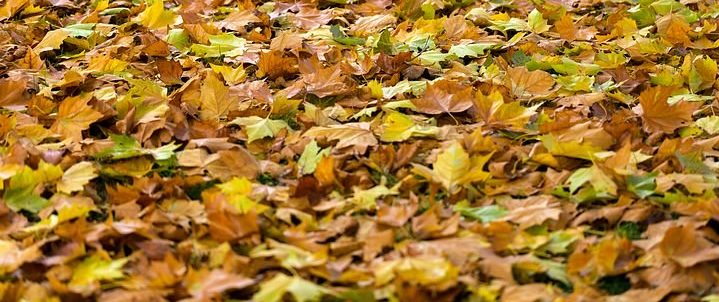Autumn is just around the corner, and with those dropping temperatures and stronger winds also comes the inevitable falling of the leaves. While this can be a magical sight, it can spell danger for your lawn. Too many wet, fallen, leaves on the lawn can act as a kind of blanket; smothering the grass and eventually killing it. And it’s not just the lawn where leaves can be a menace; garden paths, patios, and driveways can all become slippery if left to be soaked by the rain, and this is an invitation for accidents.
It doesn’t all have to be doom and gloom though. These leaves can actually be very useful; as we will explain later in this article. But to make use of the leaves, you first need to know how to collect them, so this is why we have put together this guide on the best ways to clear leaves from your garden.

We have had a look at the possible options, and given our thoughts on them. Hopefully this will help you to decide on the method that suits you best.
Best ways to clear leaves
Leaf rake
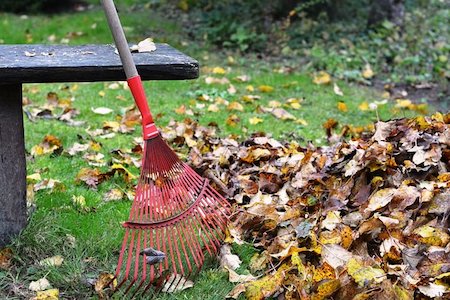
The classic method is to use a simple leaf rake. If you go down this path, use a plastic or rubber rake and not one with hard metal tines, as they can damage your lawn and are actually pretty inefficient at moving leaves.
Rake the leaves into piles and then bag them up to be either disposed of, or used for leaf mould
Leaf grabbers
These work well when used with a leaf rake; or by themselves. They are basically Large plastic scoops that you can wear on your hands like gloves, making it much easier and faster to pick up large piles of leaves. These grabbers can be bought really cheaply and are a great hand tool to have.
Broom
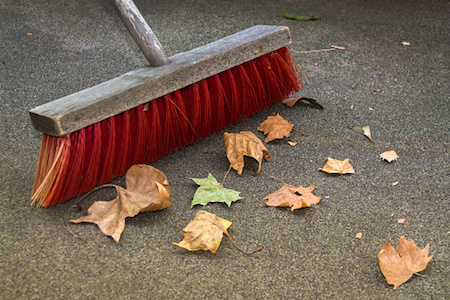
A good old broom is a very inexpensive way of clearing leaves off hard surfaces like your patio and driveway. Just like the two methods above, using a broom will save you money, but will take more time and involve physical exertion.
Leaf blower
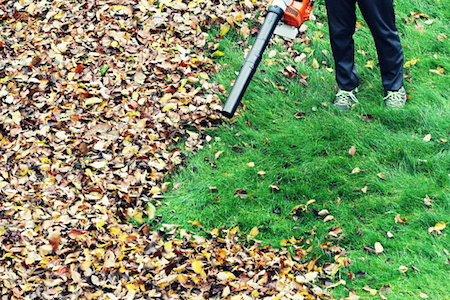
If hard graft isn’t your thing, you can make things much easier on yourself by using a leaf blower. These tools come in various sizes and can be mains, battery, or petrol powered.
Best petrol leaf blower
Petrol leaf blowers are the most powerful, but you have to think about maintenance and the higher cost. Electric models are less expensive and a little bit quieter (though still loud).
Even with a leaf blower doing most of the work, you should still have a pair of leaf grabbers to make bagging up easier after the leaves have been piled up.
Rotary lawnmower
If you have a good rotary lawnmower with a collection bag, you can use it to collect leaves off your lawn. Crank it up to the most powerful setting and just go over the lawn as you normally would. A decent rotary mower will suck the leaves up and shred them on their way to the collection bag.
Leaf vacuum
These work in the opposite way to leaf blowers and suck up the leaves rather than blowing them into a pile.
Leaf vacuums not only suck up the leaves, they also shred and collect them. Shredded leaves break down faster than whole leaves, and so this is my favourite way to deal with leaves in my own garden.
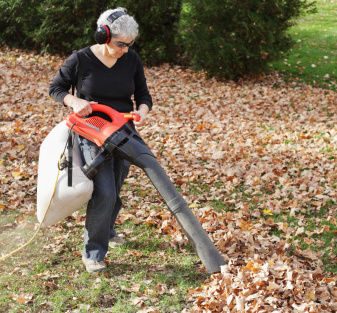
My advice is this: if you’re going to buy a leaf vacuum, pay the extra and get a top rated one. Cheap leaf blowers that don’t do the job properly are more of a pain in the backside than you can imagine, whereas a good one is worth its weight in gold.
Blower/vacuum combo tools
These are just what they sound like: a combination of a leaf blower and a leaf vacuum.
Again, my advice to you is to do your homework and spend what you need to get a good one. Some of these tools can be an absolute nightmare to change from one mode to the other, and it’d be easier just to have two separate tools.
however, if you get a good one that only requires a flick of a switch to change modes, they can be invaluable in the ongoing war on leaves.
Wheeled leaf vacuums
These are the right choice if you have a large garden to clear. A good petrol leaf blower will have the power to clear a large area, but carrying that thing around for a long time can get very tiring. Because these tools are set on wheels, there is less chance of you straining your back or shoulders while clearing leaves from a large area. They also have other advantages, with some models having extra large collection bags for the shredded leaves.
What to do with your collected leaves
An excellent use for those collected leaves is to make leaf mould out of them. Here’s an article on composting leaves quickly to help you along the way.
Leaf mould can be used moisten and enrich soils, to make composts, and is very easy to make; so, here’s how you do it:
- To make leaf mould you need shredded leaves, so you should ideally use a leaf vacuum to collect them, or have a separate leaf shredder. A rotary mower can also be used as a makeshift shredder, but different models will deliver different results for this.
- Check that the leaves are not too dry. They should be soft and moist, and if they are not, you need to grab the hose and give them a little spraying with water to make them so.
- Once shredded and moist, fill plastic bin liners with the leaves and then tie the ends shut (or seal another way). You now need to poke a few holes in the bag to let air in.
- Finally, store the bags out of the way somewhere and then all that’s left to do is wait while nature does the rest of the work for you.
In about a year’s time, those leaves that you were going to dispose of will now be transformed into some incredibly useful leaf mould.
Other ways to use collected leaves
The leaves you collect from your garden can alternatively be used as mulch after they are shredded and can be a great way to improve the soil beds in your garden. Mulching like this can help stay off weeds and improve the moisture levels of the soil.
Another use for them is to combine them with vegetable peelings and other organic material to make a compost heap.
